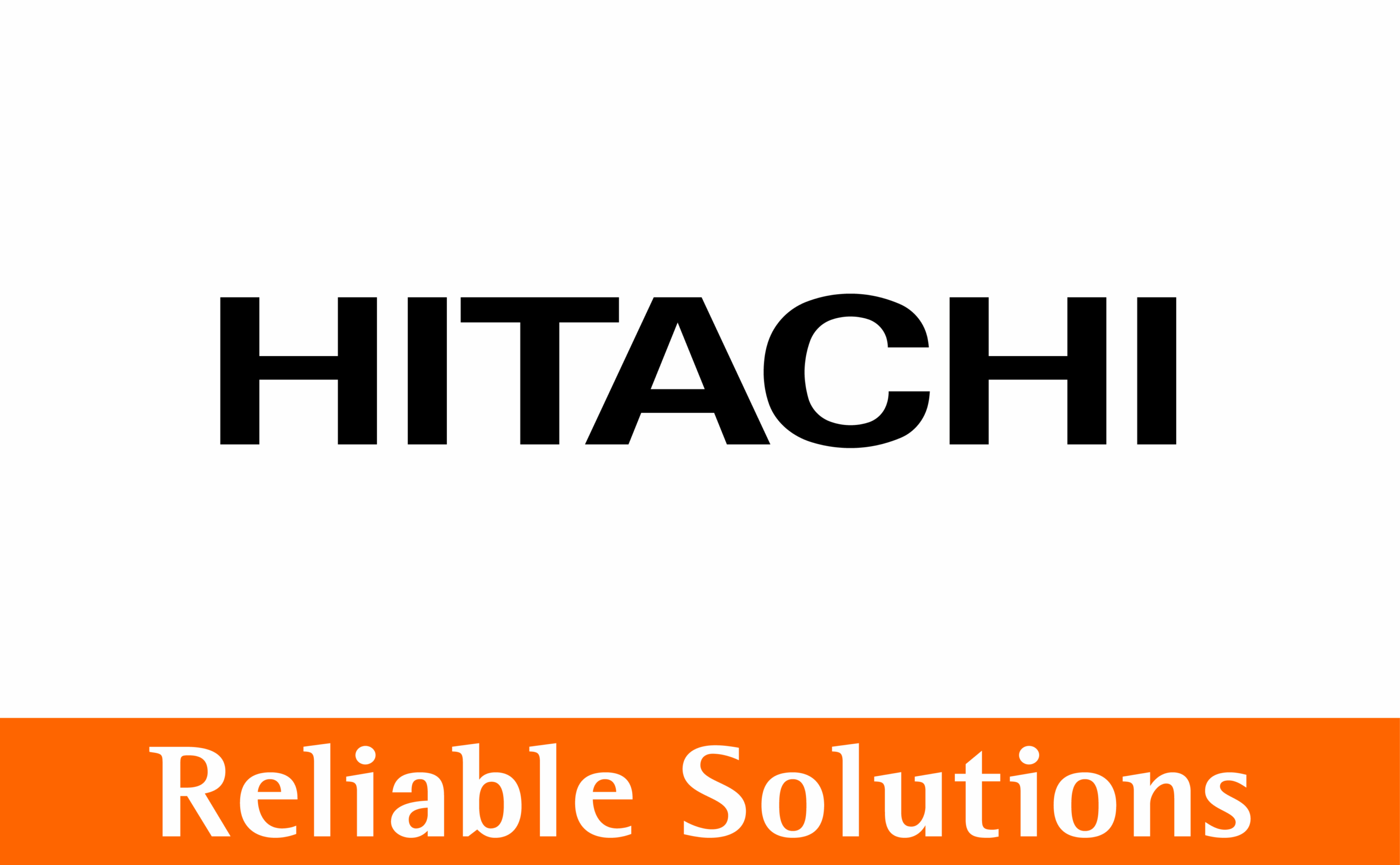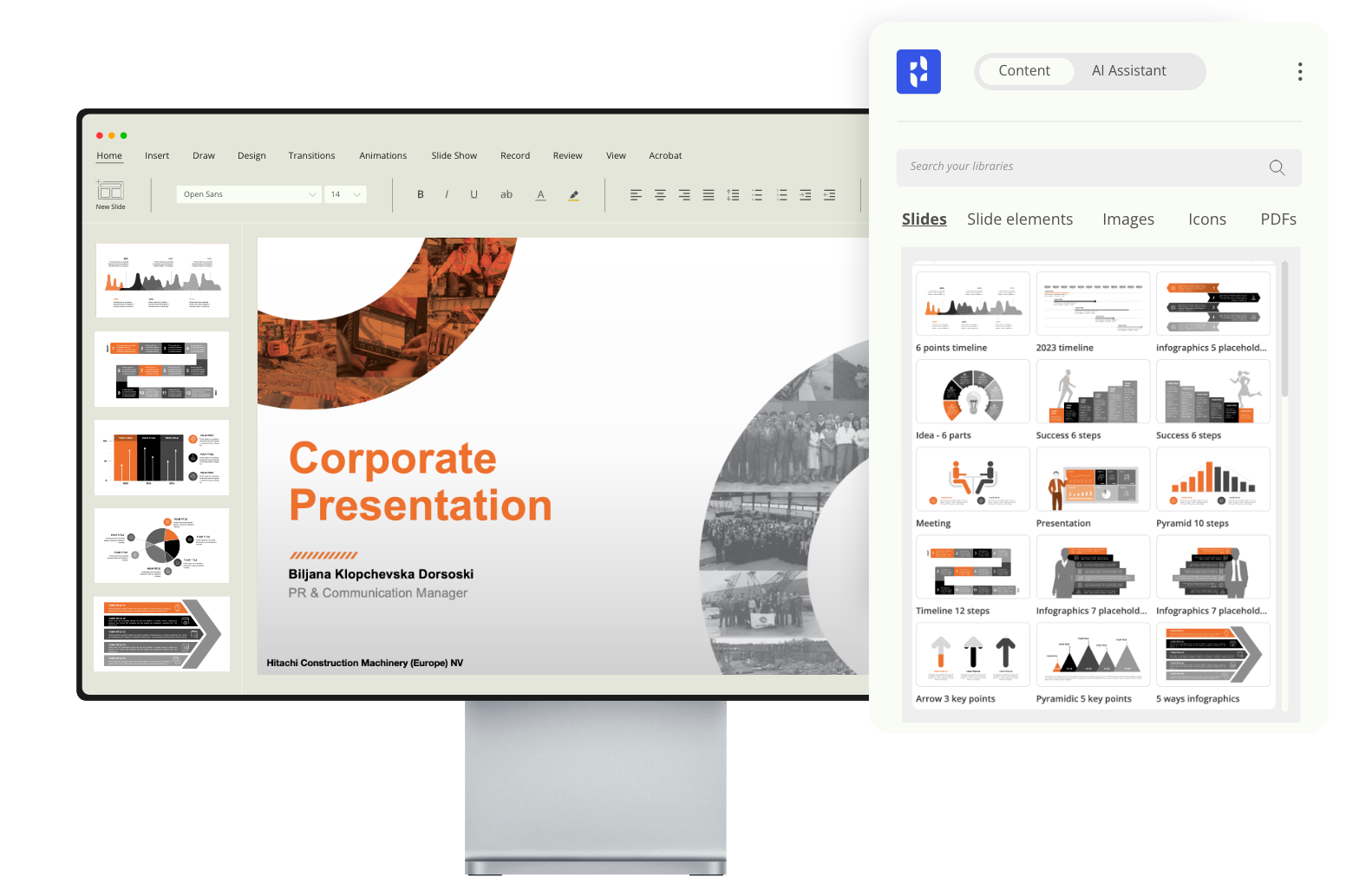CASE STUDY
Simplifying document creation in a diverse workforce
“Instead of colleagues coming to marketing saying, “I can’t locate this asset” or “Where should I look for that resource,” we can simply direct them to Templafy.”
Biljana Klopchevska Dorsoski
Communications and PR Manager, Hitachi Construction Machinery Europe


INDUSTRY
Construction equipment manufacturing
OFFICE LOCATIONS
European headquarters in the Netherlands, with global network
EMPLOYEES
600+ across 40+ nationalities
Scalable brand solutions for a diverse workforce
As part of the third-largest construction machinery manufacturer in the world, Hitachi Construction Machinery Europe (HCME) serves customers across Europe and parts of Africa with specialized equipment, service, and support.
With more than 600 employees across multiple locations, maintaining brand excellence at scale requires sophisticated infrastructure. We spoke with Biljana Klopchevska, Communications and PR Manager, about her strategic approach to brand stewardship and how Templafy has elevated asset management, email signatures, and brand consistency across the organization.
The results
- One central, trusted place for all templates, assets, and signatures
- Simplified workflows with self-service access to the right materials
- Stronger brand consistency across 600+ employees and multiple departments
The challenges
- Employees struggled to find the right materials across multiple platforms (SharePoint, DAM, dealer portal, internal drives)
- Inconsistent email signatures with manual updates managed by marketing
- Heavy reliance on one person to police brand use and provide assets
What does your everyday work look like, and what were some of your challenges before Templafy?
I’ve been with HCME for three years as PR and Communications Manager. I’m responsible for safeguarding our public image, launching new products and services, and ensuring our tone of voice and visual identity remain distinctive and consistent across all touchpoints.
Internally, colleagues call me the “brand watcher”, which is a role I take seriously because brand equity is one of our most valuable assets. My focus is helping teams understand not just the rules, but the strategic thinking behind them: why certain visuals matter, how consistency builds recognition, and what makes our brand stand out in a competitive market.
Before Templafy, one of my biggest challenges was scaling this brand intelligence across the organization. We had strong guidelines and quality assets, but the infrastructure for activating them wasn’t keeping pace with our growth.
Even straightforward tasks like locating the correct logo variation or accessing the latest product photography required more steps than necessary. If brand guardianship felt complex for me, I knew it was even more challenging for colleagues managing their own communications.
How were brand assets managed before Templafy?
When I joined, we already had established brand standards and a solid foundation of materials. However, as the company evolved, our asset ecosystem had naturally expanded across multiple platforms: SharePoint, our dealer portal, a DAM system, and various internal drives. Each served a purpose, but together they created a fragmented experience.
For employees, especially new team members, navigating this landscape meant understanding not just what to use, but where to find it. The guidelines existed, but the path to the right assets wasn’t always intuitive. I recognized this wasn’t just an operational challenge; it was limiting our ability to maintain the brand excellence we were capable of.
“If brand guardianship felt complex for me, I knew it was even more challenging for colleagues managing their own communications.”
Biljana Klopchevska Dorsoski
Communications and PR Manager, Hitachi Construction Machinery Europe
What made you choose Templafy?
I first encountered Templafy years ago at another organization, and what impressed me then (and still does now) is its strategic positioning: activating brand assets directly within the tools people use every day, particularly Microsoft Office. That integration philosophy aligned perfectly with how modern teams actually work.
At Hitachi, email signatures emerged as a clear opportunity for improvement. We had processes in place, and marketing would distribute updated templates periodically, but execution varied. It wasn’t a matter of people not caring about the brand; it was that the system required manual effort that competed with daily priorities. Inconsistency was the natural result.
I wanted a solution that would embed brand compliance into the workflow itself, eliminating friction rather than just adding rules. The goal was to make doing the right thing the easiest thing, while giving our teams access to professional-grade materials that truly reflected the quality of our business.
How was the rollout and onboarding process?
I invested several months upfront in strategic preparation: building templates, creating an intuitive taxonomy, and thinking through how different roles would interact with the system. This foundation work was critical. I wanted to ensure that when we launched, people would immediately understand the value proposition and trust the platform as their primary resource.
The IT approval process gave me valuable time to refine the structure. By launch day, everything was positioned strategically, and the benefits were immediately visible. The reception was so positive that I naturally became an internal advocate for the platform.
What surprised me most was the interest from other divisions. Colleagues from Hitachi Rail reached out to learn about our approach, and I was happy to share our onboarding materials and implementation experience. That cross-divisional interest validated that we’d solved a challenge many teams face as they scale.
“When it went live, everything was in the right place and people could see the value immediately.”
Biljana Klopchevska Dorsoski
Communications and PR Manager, Hitachi Construction Machinery Europe
How is daily work different now?
The transformation is substantial. We’ve moved from reactive brand management to proactive enablement. Instead of colleagues coming to marketing saying, “I can’t locate this asset” or “Where should I look for that resource,” we can simply direct them to Templafy. But more importantly, they’re increasingly discovering materials independently, which was always the goal.
There’s a new level of confidence across the organization. When employees create documents, presentations, or communications, they know they’re working with current, approved materials that reflect our brand standards. This confidence translates into higher quality output. When we collaborate on presentations, everyone is aligned from the start and working from the same strategic foundation.
The efficiency gains are quantifiable. In just the past year, we’ve documented approximately 2,010 working hours saved (equivalent to 268 working days) simply through more streamlined document workflows. But beyond time savings, we’ve elevated the consistency and professionalism of every customer-facing touchpoint.
What kind of feedback have you received since rollout?
The response has been overwhelmingly positive. People genuinely appreciate having a single, reliable source for brand materials rather than navigating multiple repositories. It’s transformed a previously fragmented experience into something seamless.
The adoption metrics tell a compelling story: today, 87% of all documents created at HCME come through Templafy. We’re talking about approximately 13,331 documents so far. For me as brand steward, this means we’ve dramatically increased the percentage of materials that meet our brand standards—not through enforcement, but through enablement. That’s exactly the outcome we envisioned.
“Instead of colleagues coming to marketing saying, “I can’t locate this asset” or “Where should I look for that resource,” we can simply direct them to Templafy.”
Biljana Klopchevska Dorsoski
Communications and PR Manager, Hitachi Construction Machinery Europe
How would you describe Templafy to people who haven’t heard of us?
I tell people that Templafy is a strategic brand infrastructure platform. If you invest time upfront in thoughtful organization and clear structure, the system becomes almost self-sustaining. It truly operates as an intelligent resource: you access it, find what you need with minimal friction, and get back to your core work.
What stands out most is the consistency it enables across the entire organization. Whether you’re in sales, operations, or at headquarters, everyone works from the same high-quality materials. The proof is in the interest from other divisions—colleagues across Hitachi have reached out asking how they can adopt the platform because they see the tangible benefits.
For me personally, brand stewardship has evolved from firefighting to strategy. Instead of constant course correction, I can focus on higher-value work: refining our visual narrative, planning campaigns, and thinking about how we want to position our brand for the future. When questions do arise, resolution is immediate because there’s a clear, trusted source of truth.
At the end of the day, this is about empowering your organization with professional-grade tools and assets in a single, accessible location. When you combine quality materials with an intuitive system, you unlock the kind of brand consistency and productivity that drives real business impact.
The solution
Centralized asset library
All brand assets, product images, templates, and guidelines are uploaded and managed in Templafy’s cloud-based library, ensuring one single source of truth.
Real-time content updates
Marketing can distribute new templates, slides, and visuals instantly to employees across all regions and departments.
Direct integration with Microsoft Office
Templafy is embedded into Word, PowerPoint, and Outlook, so employees can access approved materials without leaving the applications they already use.
Automated email signature management
Company-wide email signatures are created, updated, and rolled out through Templafy’s signature manager, removing the need for manual updates.

working hours saved since implementing Templafy
of all documents created through Templafy

About Hitachi Construction Machinery (Europe)
Hitachi Construction Machinery (Europe) NV (HCME) was established in 1972 and is based in Oosterhout, the Netherlands. With more than 600 employees, HCME is responsible for the manufacture, sales, and support of Hitachi construction equipment across Europe and parts of Africa. The company supplies a full line of specialized machinery and provides customers with dedicated service and equipment for infrastructure and construction projects.